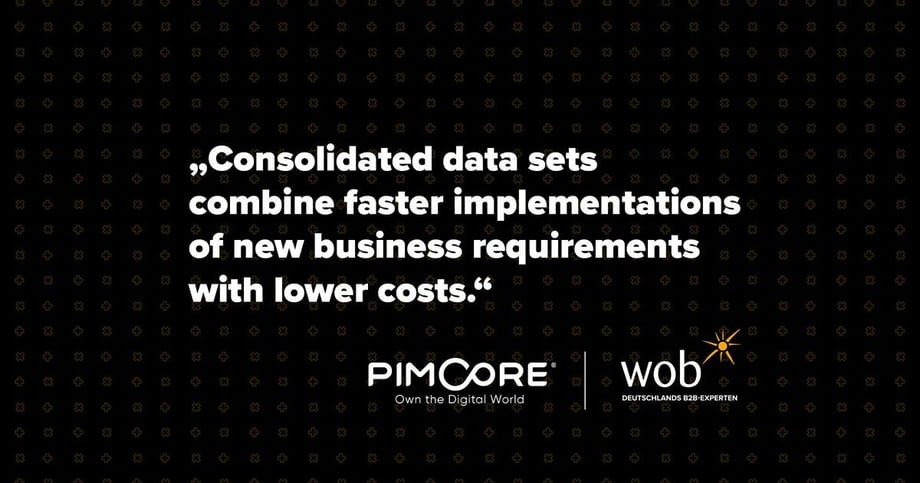
Im Zuge vieler heutiger Website-Projekte stellen sich oft Fragen zur Erfassung, Verwaltung und Nutzung von Daten. Customer Data Platforms (CDP) und/oder Master Data Management (MDM) können dabei sehr hilfreich sein. In diesem Artikel erklärt Ihnen wob, wie diese Lösungen funktionieren und welche typischen B2B-Aufgaben sie Ihnen abnehmen können.
CDP und MDM: Was Sie wissen müssen
Kurz gesagt geht es bei beiden Lösungen in erster Linie darum, personenbezogene Daten oder verschiedene andere Datenfelder - wie Kunden oder produktbezogene Daten - strukturiert zu verwalten und nutzbar zu machen. Liegt der Schwerpunkt der gesammelten Daten auf Namen, Adressen und ähnlichem, spricht man von einer "Kundendatenplattform". Handelt es sich speziell um Adressdaten, zentral verwendete IDs und Produktinformationen, spricht man von einer "Master Data Platform".
Alle Anfänge sind schwer - und unauffällig
Wer in das datengetriebene B2B-Marketing einsteigen will, wird sich zunächst oft mit einfachen Aufgaben beschäftigen: zum Beispiel mit der Personalisierung des Einstiegspunktes einer Website oder der schnellen Integration eines neuen Formulars auf der Website. Vielleicht sollen die Daten aus einer E-Mail-Automatisierungslösung mit dem Webtracking verbunden werden. Oder es sollen Datensegmente mit Bezug auf das Nutzerverhalten befüllt und später über die Marketing-Automation genutzt werden. Die Liste ließe sich beliebig fortsetzen.
Klassische Content-Management-Systeme wie WordPress oder auch große Plattformen wie der Adobe Experience Manager bieten solche Funktionalitäten jedoch nicht out of the box. Daher ist es notwendig, Drittsysteme einzubinden oder zusätzliche Lizenzen zu erwerben. Datenmanagement-Produkte von spezialisierten Anbietern wie Marini Systems bieten zwar einige nützliche Funktionen, aber in der Regel sind diese Lösungen für B2B-Marketingprojekte nicht optimal geeignet.
Hier ist, warum Pimcore unsere Wahl ist
Als B2B-Agentur und kundenorientierter Geschäftspartner haben wir bei wob ein System gewählt, mit dem wir unseren Kunden die besten Möglichkeiten bieten können - in unserem Fall ist das Pimcore. Mit seinen tiefgreifenden CDP- und MDM-Fähigkeiten lässt sich das Customer Management Framework (ein kostenloses Plugin der Pimcore-Community) schnell in Betrieb nehmen, das ausgefeilte Möglichkeiten zur Sammlung, Verwaltung und schließlich Nutzung der gewonnenen Daten bietet. Ein einfacher Anwendungsfall wäre, mit wenigen Klicks eine Zielgruppe zu definieren ("Alle Nutzer, die sich mindestens dreimal eingeloggt haben") und dann bestimmte Inhalte an diese Zielgruppe zu verteilen ("Willkommen zurück. Das waren Ihre zuletzt besuchten Seiten.").
CDP und MDM im B2B: Wie sollte man das Thema angehen?
Modernes Marketing ist gemeinhin eine Frage von Daten und Technik. Deshalb dienen Kundendaten oder Stammdaten aus verschiedenen Quellen als Grundlage für erfolgreichere Kampagnen oder Markenkontaktpunkte. Schauen wir uns das einmal genauer an:
- Integration: Die Nutzung von Daten aus anderen Systemen (z.B. ERP, CRM, Automation, Adressbroker) ermöglicht das Zusammenführen von Basis- und Verhaltensdaten zu einem "einheitlichen Profil". In diesen einheitlichen Profilen sind alle gesammelten Daten übersichtlich angeordnet und können von Marketing- und Vertriebsabteilungen zur gezielten Ansprache von Kontakten und Leads genutzt werden.
- Segmentierung: Darüber hinaus bietet Pimcore die Möglichkeit, dynamische Clusterungen von Nutzern zu erstellen, die als automatisierte Segmente bezeichnet werden. Dies vereinfacht nicht nur die Auswertung - zum Beispiel durch die Möglichkeit, alle Conversions eines bestimmten Nutzertyps anzuzeigen - sondern auch durch die Verteilung von relevanteren Informationen.
- Personalisierung: Eine von uns entwickelte Plattform bietet spezifische und nutzeroptimierte Inhalte für registrierte Nutzer. Die Basis dafür bilden zum einen Profilinformationen (Basisdaten etc.), der andere Teil besteht aus Informationen, die aus dem Verhalten der Nutzer abgeleitet werden (Segmente etc.). Je besser die Personalisierung der Inhalte ist, desto größer sind die Chancen auf eine Kontaktaufnahme bzw. auf Projektanfragen.
- Automatisierung: Die auf diese Weise gewonnenen und optimierten Datenströme können nun in automatisierte Prozesse überführt werden. Über die offenen Schnittstellen des Systems - Pimcore bietet diesbezüglich zahlreiche APIs zur Anbindung von Drittsystemen - können E-Mail-Kampagnen ausgelöst und Aufgaben und Tickets in das CRM eingepflegt werden. Dadurch wird eine klassische Website mit dem passenden CDP/MDM zum Ausgangspunkt für eine ganzheitliche Marktbearbeitung.
- Skalierung: Unternehmen, die diese Systeme plattformübergreifend und zentral gesteuert einsetzen, haben große Skaleneffekte in Aussicht. Ein konsolidierter Datenbestand spart nicht nur Kosten für die System- und Datenpflege, er kann auch viel schneller umgesetzt werden, um neue Geschäftsanforderungen zu realisieren.
- Reporting: Und wie viel schneller all dies zu messbaren Erfolgen führen kann, lässt sich mit einer sauberen CDP/MDM-Landschaft im Vergleich zu einer Vielzahl einzelner Data Hubs viel leichter erkennen. Darüber hinaus können Visualisierungstools wie MS Power BI oder Tableau eingesetzt werden, um den Erfolg Ihrer optimierten Marketing-Infrastruktur in tatsächliche Gewinne umzuwandeln.
Erfolg durch Teamwork
Sie ahnen es schon: Modernes Marketing ist kein einfaches Unterfangen. Vor allem der Aufbau einer Customer Data Platform oder eines Master Data Management Systems ist für Marketer meist Neuland und nur mit intensiver Unterstützung von IT- und Vertriebsabteilungen zu bewerkstelligen. Wenn man sich aber gemeinsam an diese Aufgabe macht, können die Ergebnisse beeindruckend sein und letztlich mehr Geschäft generieren - und mehr (Budget-)Spielraum für die nächste Marketingkampagne.